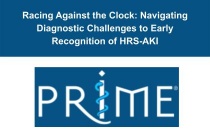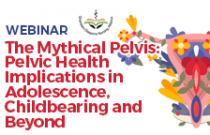Racing Against the Clock: Navigating Diagnostic Challenges to Early Recognition of HRS-AKI
Michael Curry, Todd Frederick, Michael R Stinchon, Richa Bhattarai, Annette Sophin, Kristi Kay Orbaugh
1.00 Hours
Timely recognition of hepatorenal syndrome-acute kidney injury (HRS-AKI) is crucial for initiating treatment early, reversing the condition, and improving patient outcomes. However, identifying HRS-AKI in practice is often complicated by the need to apply specific diagnostic criteria to complex patient presentations. Tune in....
Breaking the Silence. Episode 1: Empowering Local Voices: Strengthening Community-Based Mental Health Initiatives in Africa
Dr. Akwasi Duah, D. Brenda Owusu, Mr Francis Yeboah, Mrs, Katrina Binutu, Osei Boateng
Breaking the Silence: Advancing Mental Health Awareness in Africa through Global Partnerships, Media, and Community Action Episode 1: Empowering Local Voices: Strengthening Community-Based Mental Health Initiatives in Africa Mental health remains one of the most neglected public health issues across Africa. It is often silenc....
Navigating Change: The Educational and Cultural Transition Experiences of Migrant Filipino Nurses.
Dr. Glenn Ford Valdez PhD,EM,DNM, PhD-NS(eu),Rn-CNE-cl
This webinar presents a qualitative phenomenological study on the socio-educational and acculturation experiences of Filipino nurse-migrants in eight countries. Using Colaizzi’s seven-step method, interviews with ten nurses revealed seven key themes: emotional and cultural challenges, language barriers, systemic credentialing ob....
The Mythical Pelvis: Pelvic Health Implications in Adolescence, Childbearing and Beyond
Kristi Kliebert
Guided discussion of pelvic health across the woman’s lifespan and practical strategies to assist with pelvic health dysfunctions.
An Introduction to Pharmacometrics
Dr Lufina Tsirizani
This session aims to strengthen the knowledge and competencies of pharmacists, pharmacy technicians, researchers and other healthcare professionals by introducing them to the principles and applications of pharmacometrical research and clinical practice.
Research Proposal Writing
Associate Professor Felix Khuluza
This lecture aims at equipping participants with skills for conceptualizing and structuring high quality research proposals, which is a critical foundation for academic and professional research.
Presentation and Dissemination of Research Projects and Publications.
PHASOM Members
An opportunity to view how colleagues showcase and share their outstanding research contributions.
NCD Operations M4: Action Plans
Mr WCEA Administrator
It is now time to put all of your learning into practice by developing an action plan for improving the care of NCD patients in your setting.
Quenching the fire of GERD, quenching the 'fire' in the stomach
Dr. Adwoa Agyei-Nkansah
This webinar is designed to update healthcare professionals (HCPs) on the latest advancements in managing Peptic Ulcer Disease and Gastro Esophageal Reflux Disease (GERD). Learn about current trends in diagnosis and treatment, including emerging therapies. Plus, discover why Pariet is positioned as the leading oral proton pump....
(DRM) TEST FIX Maternal, Child, & Adolescent Nutrition in Ghana: Assessment & Intervention
Mr WCEA Administrator
(DRM) TEST FIX Maternal, Child, & Adolescent Nutrition in Ghana: Assessment & Intervention
Community Pharmacy Services
Mr Emmanuel Chiona
Community pharmacies play a vital role in healthcare delivery. This session provides an overview of essential services and explores advanced and enhanced offerings that are redefining the profession. As the pharmacy landscape continues to evolve globally, we'll discuss the emerging roles of community pharmacy personnel. A k....
fit to performe - rise strict mode
Miss Samantha Chapman
Author Information* Author information is taken from your Author Profile but can be edited for this course here.
Safe Injection Practices & IV Push Guidelines: Compliance with CDC & CMS CoPs
Sue Dill Calloway, RN, MSN, JD
CMS has issued memos instructing hospitals to follow particular standards of care, such as those issued by ISMP, the CDC standards on safe injection practices, and the four unsafe injection practices that can earn a facility a second survey, this time from the state epidemiologist. More than 90% of hospitalized patients recei....
Understanding Restraint and Seclusion: CMS, DNV and TJC Guidelines and Best Practices
Sue Dill Calloway, RN, MSN, JD
Restraint is the number one deficiency hospitals are penalized for in the Hospital CoP because the restraint policy is one of the hardest to write and understand for healthcare employees. CMS published 10 pages of restraint training requirements for hospitals to implement. This program will simplify 50 pages of the CMS restra....
Safe Injection Practices & IV Push Guidelines: Compliance with CDC & CMS CoPs
Sue Dill Calloway, RN, MSN, JD
CMS has issued memos instructing hospitals to follow particular standards of care, such as those issued by ISMP, the CDC standards on safe injection practices, and the four unsafe injection practices that can earn a facility a second survey, this time from the state epidemiologist. More than 90% of hospitalized patients recei....
Prudent Use of Antibiotics (Part 2)
Nicholas Cooley, Greg Scutt & Paul Wade
0.50 Hours
The aim of this session is to promote rational use of antibiotics in optimising treatment of patients with infections and reducing emergence of antibiotic resistance. Risks associated with antimicrobial use in patients who may have penicillin allergy will be explained.
2017 Proposed Changes to CMS Nursing CoPs
Sue Dill Calloway, RN, MSN, JD
Nursing CoPs have gone through many changes in the past few years, and there are more proposed changes scheduled for 2017. It is crucial that all nurses are trained on the CMS nursing chapter so hospitals won’t get fined for deficiencies. CMS made significant changes to the nursing chapter, including: IV medication administra....
Transmission of STIs and HIV
Mr WCEA Administrator
GUM_16_006GUM_16_006GUM_16_006GUM_16_006GUM_16_006
Retinopathy of Prematurity: An overview lecture
Dr Iddi Ndyabawe and Dr Dan Bwonya
Discuss Retinopathy of Prematurity from its definition, its pathogenesis, how it is staged, how ROP is screened and how it is managed.



















